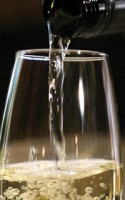The Other White Wine
It’s time to give sauvignon blanc a chance
 Sauvignon blanc is the redheaded stepchild of the white wine world. While she is quite appealing and affable, she has never been able to garner the glory, the respect or the adoration of her cherished sister, Chardonnay.
Sauvignon blanc is the redheaded stepchild of the white wine world. While she is quite appealing and affable, she has never been able to garner the glory, the respect or the adoration of her cherished sister, Chardonnay.
Sauvignon blanc is the redheaded stepchild of the white wine world. While she is appealing and affable, she has never been able to garner the glory, the respect or the adoration of her cherished sister, Chardonnay. Even though both are members of the noble grape family, it is Chardonnay upon which honors, accolades and recognition are continually bestowed. Wine connoisseurs continue to devour her, and wine experts continue to praise her for her complexity and longevity. So, what is poor sauvignon blanc to do? Does she drown herself in self-pity and shrivel into oblivion? Does she angrily wage a war against such grape injustice? No, she proudly holds her head up high and merely accepts herself for the uncomplicated, lively and quaffable grape that she is.
Sauvignon blanc is native to France, specifically the Loire Valley, where it produces wines labeled Sancerre and Pouilly-Fumé (not to be confused with Pouilly-Fuissé, a 100% Chardonnay wine from Burgundy.) Loire Valley whites tend to possess a distinct flinty quality, due to the region’s limestone hills, and are somewhat austere. Additionally, sauvignon blanc is one of the two primary white grapes used in the Graves region of Bordeaux (semillon being the other), which are typically blended to produce crisp, lively wines with honey and melon characteristics. And, while semillon is the key grape used to make one of most revered dessert wines in the world, that being Sauternes, sauvignon blanc is added to give structure and acidity to these remarkably sumptuous wines.
In addition to its success in France, sauvignon blanc is harvested in California, where it is commonly known as Fumé Blanc, thanks to the marketing efforts of Robert Mondavi. The grape first came to the United States in 1858 and was planted east of San Francisco. While it flourished in the gravelly soil, it failed to make an impact on wine consumers, as it had a reputation of being a lackluster wine, even on the sweet side. Mondavi began to craft his sauvignon blanc in a style similar to that in France, then label this unfashionable varietal as “Fumé Blanc.” Its popularity soared. Today, California sauvignon blanc still ranks far behind Chardonnay in status and production, but it continues to attract fans seeking an alternative to the heavier, typically oak-laden Chardonnay. While some California producers do use some oak to add richness, most prefer to impart little if any, producing a fresh, lively, zesty wine with citrus and grassy flavors and the trademark herbaceous (or even cat pong) aroma.
New Zealand, which began importing affordable top-notch examples of sauvignon blanc in the 1980s, has played an integral role in boosting the awareness of the varietal. Although the first plantings did not occur until the 1970s, shortly after the first cases hit American soil, New Zealand sauvignon blanc was discovered and appreciated for its refreshing, crisp quality. By the 1990s, it was firmly established as the country’s flagship wine and today is the country’s most widely planted grape. Lemon zest, grapefruit, flint, peach, gooseberry and nectarine are common descriptors for the aggressive acidity and powerful grassy notes of sauvignon blancs.
While sauvignon blanc is made in virtually every major wine-producing region, other areas that are turning out notable examples include Chile, Argentina, South Africa and to a lesser degree Italy and Washington State.
In addition to being a great value (it’s a challenge to find a bottle that tops $25 and many retail for under $15), sauvignon blanc is admired for its ability to complement many styles of cuisine. The wine is a natural to pair with “white meats,” from oysters and scallops to chicken, veal and pork. Due to its herbaceous quality, it has the ability to complement “green” flavors such as fresh herbs, leafy greens, olives and fennel, while its refreshing nature tends to perfectly balance spicy flavors like curries, Cajun spices, Thai and Mexican foods. A classic pairing with goat cheese, sauvignon blanc also works well with smoked salmon, grilled fish, vegetables and is a superb aperitif. But mostly, sauvignon blanc—refreshing, unpretentious and purely delightful—is the quintessential summertime quaffing wine, so step aside, Chardonnay and let her have her day in the sun.
